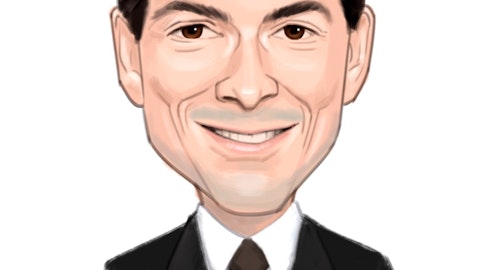If you are looking for the best ideas for your portfolio you may want to consider some of Greenlight Capital’s top stock picks. Greenlight Capital, an investment management firm, is bullish on Brighthouse Financial Inc. (NASDAQ:BHF) stock. In its Q4 2019 investor letter – you can download a copy here – the firm discussed its investment thesis on Brighthouse Financial Inc. (NASDAQ:BHF) stock. Brighthouse Financial Inc. (NASDAQ:BHF) is a life insurance company. The stock is down 36.5% since the Greenlight Capital’s pitch in January 2020, which suggests the investment firm was wrong in its decision. On a year-to-date basis, Brighthouse Financial Inc. (NASDAQ:BHF) stock has fallen by 32%.
On January 21, 2020, Greenlight Capital had released its Q4 2019 Investor Letter. Greenlight Capital said that Brighthouse Financial Inc. (NASDAQ:BHF) stock is currently cheaper than a year ago. This isn’t the first time Greenlight Capital talked about Brighthouse Financial Inc. (NASDAQ:BHF) favorably either. The investment firm has been a long time Brighthouse Financial Inc. (NASDAQ:BHF) bull. A year ago we shared Greenlight Capital’s bullish Brighthouse Financial Inc. (NASDAQ:BHF) thesis in this article.
In 2019, the Greenlight Capital Fund recorded a return of 13.8% as compared to 31.5% of the S&P 500 Index.
Let’s take a look at comments made by Greenlight Capital about Brighthouse Financial Inc. (NASDAQ:BHF) in the letter.
“This remains one of the most perplexing investments we have ever made. Although the shares “recovered” 29% in 2019, the underlying value of the business also improved, so much so that the shares are arguably cheaper now than they were a year ago.
BHF’s main business is variable annuities. Customers deposit funds into segregated accounts, which are then invested in equity and fixed income funds, and pay BHF fees in exchange for minimum performance guarantees. The biggest risk BHF takes (and must hedge) is that equity markets underperform and the company has to make good on these minimum guarantees. When markets do poorly, policies can become “upside down,” meaning the guaranteed policy benefits exceed the value of the assets in the separate accounts. Policies written with assumptions that are too optimistic cause trouble for variable annuity writers, as was the case from 1998 to 2011 when the S&P 500 index was essentially unchanged.
In 2019, the S&P 500 returned 31.5%, bringing its return since 2011 to 203%, or almost 15% annualized. Separate account returns have been vastly exceeding the underwriting assumptions, making it very unlikely that many variable annuity policies are presently upside down. We posit, if the policies are performing this well, why should the business have any discount to book value?
In nearly every analyst report (1 buy, 9 holds, 4 sells), potential investors are given stern reminders that BHF is “sensitive” to equity markets. Analysts seem to be ignoring (or in a couple cases underplaying) that this sensitivity goes both ways. Since none of the analysts have delved into what happens to BHF in a strong stock market, it’s no surprise that they don’t recommend the stock.
BHF’s annual report provides certain sensitivities showing intermediate-term cash flows from the variable annuities segment based on hypothetical capital markets scenarios. We estimate that the 31.5% gain for the S&P 500 incrementally added at least $2 billion to BHF’s distributable cash flow over the next four years. BHF’s entire market capitalization is only $4.2 billion. The company will release new sensitivity tables next month.
In 2018, the company announced that it would return $1.5 billion to shareholders by the end of 2021. At that time, management was clear that its targets were sensitive (in both directions) to capital markets. As a result, we believe there is an excellent chance BHF will exceed its capital return targets. Even at current levels, the company is buying back stock at a rate of over 1% of the company each month. Given the discount to book value, the buyback alone is causing book value per share to grow by 10% per year, in addition to the company’s earnings.
The bears’ latest bugaboo is that around 2022, BHF will be subject to a change in accounting, which could lead to a “sizable” non-cash charge and reduction of book value. We note that the shares already trade at only 31% of book value and that any write-down would actually have a positive impact on future earnings. We estimate that every $10 per share write-down will improve annual earnings by $0.65 per share. By our estimates, even with a $3 billion charge, book value per share is likely to grow at a double digit rate over the next 5 years and adjusted earnings per share is likely to grow even faster than book value per share. BHF shares could double from here and still be absurdly cheap.”

In Q1 2020, the number of bullish hedge fund positions on Brighthouse Financial Inc. (NASDAQ:BHF) stock decreased by about 42% from the previous quarter (see the chart here), so a number of other hedge fund managers don’t seem to agree with Brighthouse Financial’s growth potential. Our calculations showed that Brighthouse Financial Inc. (NASDAQ:BHF) isn’t ranked among the 30 most popular stocks among hedge funds.
The top 10 stocks among hedge funds returned 185% since the end of 2014 and outperformed the S&P 500 Index ETFs by more than 109 percentage points. We know it sounds unbelievable. You have been dismissing our articles about top hedge fund stocks mostly because you were fed biased information by other media outlets about hedge funds’ poor performance. You could have doubled the size of your nest egg by investing in the top hedge fund stocks instead of dumb S&P 500 ETFs. Below you can watch our video about the top 5 hedge fund stocks right now. All of these stocks had positive returns in 2020.
Video: Top 5 Stocks Among Hedge Funds
At Insider Monkey we scour multiple sources to uncover the next great investment idea. There is a lot of volatility in the markets and this presents amazing investment opportunities from time to time. For example, this trader claims to deliver juiced up returns with one trade a week, so we are checking out his highest conviction idea. A second trader claims to score lucrative profits by utilizing a “weekend trading strategy”, so we look into his strategy’s picks. We read hedge fund investor letters and listen to stock pitches at hedge fund conferences. We recently recommended several stocks partly inspired by legendary Bill Miller’s investor letter. Our best call in 2020 was shorting the market when the S&P 500 was trading at 3150 in February after realizing the coronavirus pandemic’s significance before most investors. You can subscribe to our free enewsletter below to receive our stories in your inbox:
Disclosure: None. This article is originally published at Insider Monkey.





